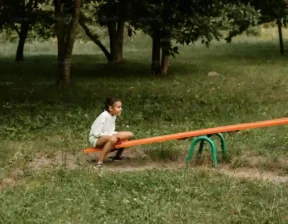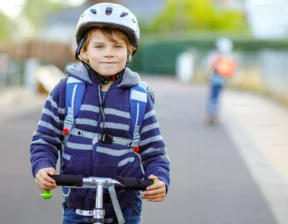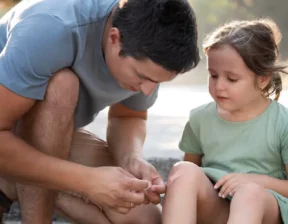
Extra 10% Off Orders above ₹2499 : Use Code: HUP10
Safest Comfort Helmet for Kids
Free Shipping | 7-Day Free Returns
Lifetime Warranty*
COD Available

by Prachi Gulati
A bicycle ride around the world begins with a single pedal stroke,” said Scott Stoll, a renowned community professor who traveled around the world on his bicycle. But what does this signify? Why did Mr. Stoll travel the world on a bicycle? What is the need for a person to learn how to ride? Why is it important to teach a child how to ride a bicycle?
The answer lies in taking the first step toward achieving one’s dreams. No matter how big or challenging they may seem, every journey, no matter how vast, begins with a small, simple action. Similarly, teaching a child to ride a bicycle is their first step in this big, expansive world. It is essential for their growth and overall physical, mental, and social development.
Read more: Latest Helmet Trends
Teaching a child to ride a bicycle is an important milestone for both the child and the parents. It encourages ascending growth, independence, and a sense of pride for a kid. Although riding a bicycle is an easy task for most of us, from a young parent’s point of view, it can be an overwhelming journey. To teach child bicycle, it requires careful planning and a supportive approach to make the experience enjoyable and rewarding for the child.
A well-conditioned safety gear for your child, including a well-fitting helmet, knee pads, and elbow pads. Always teach them the importance of wearing the gear to prevent injuries and learn all the necessary precautions.
A very important step is to select the correct bicycle according to the kid’s height, weight, and comfort level. For beginners, balance bikes or lightweight bicycles with adjustable seats are ideal.
Find an open and accessible space free from traffic and obstacles, such as a park, or a flat grassy field. A calm environment allows your child to focus on learning without distractions.
Help your child master balancing before teaching them to pedal. Allow them to use their feet to stabilize and control the bicycle. Teach your child how to scoot first, to be in a comfortable position to ride the bicycle. After that, ride in a straight line, how to take a turn. Allow your child to get a feel for applying the brakes gently to avoid a harsh and destabilizing stop.
Celebrate small victories, like staying balanced for a few seconds or taking the first pedal stroke. Do not pressurize your kid, instead use words of encouragement.
The traditional method to teach child bicycles involved parents holding the back of the bicycle seat to provide support. The parents ran alongside the child when he pedals, giving them time to gain confidence on their own to ride. This method focused on building trust and being there for the child, who often relied on the parent’s support until they could balance independently.
Before the comfortable training wheels, many parents would teach children to bicycle by first having them coast down small inclines or gentle slopes. The child would glide the slope while gently pushing the pedal with their feet. Sticks were also used by some parents in some places like Scandinavia not to hit the slow learners, but to tap into the child’s bicycle saddle.
Many parents take a slow, step-by-step approach. First, the child sits on the bike and pushes off with their feet. Then, they practice pedaling while the parent helps steady the bike, gradually learning to balance and pedal on their own.
In some communities, kids learned to ride bikes together, making it a rite of passage. Older children or friends would offer tips and encouragement to their juniors, creating a supportive environment and healthy learning atmosphere. Watching others succeed inspired the child to keep going.
Read more: Helmet Safety Testing Procedures
In the absence of modern safety gear like helmets, elbow pads, and knee pads, children typically learn to ride without much protective equipment. The main focus was on toughening them up which makes children fall and get up with little fuss.
In some cultures, parents would attach a rope or strap to the back of the bicycle to teach child bicycle. This allowed the parent to control the child’s balance easily while the child pedaled forward. It was particularly useful for preventing falls, as the parent could pull on the rope to correct the child’s balance.
Today’s parents teach kids to ride by focusing on balance first, often using balance bicycles or removing pedals to help them master it before pedaling.
Nowadays, parents are more protective of their children, they ensure their children’s safety by providing them with helmets and protective gear. With less time in their hands due to daily hustles parents encourage short, regular practice sessions in safe, flat areas and even try to celebrate every small victory. They use training wheels to ensure they do not compromise the safety of their children. They encourage independence, letting the child learn at their own pace.
Read more: Helmet Safety Ratings: Your Guide to Choosing the Best Helmet
Children progress at different speeds when learning to ride a bicycle. Some may pick it up quickly, while others might need more time to find their balance, even as they grow older. It’s important to let each child learn at their own pace—pushing them before they’re ready can do more harm than good.
With patience, praise, and support, parents can make learning bicycles fun and build confidence.
 31 July 2025
31 July 2025
Due to the continuous rise in technology, getting kids off screens can be a difficult...
 29 July 2025
29 July 2025
Young riders love the thrill of being on wheels and ride to explore nature. Whether...
 27 July 2025
27 July 2025
Nowadays, mobile phones and social media dominate childhood, and playing outdoors has been neglected. Introducing...
 25 July 2025
25 July 2025
You are running late for work; your scooter is ready, but your kid refuses to...
FIND WHAT MOVES YOU
FIND WHAT MOVES YOU
FIND WHAT MOVES YOU
FIND WHAT MOVES YOU
FIND WHAT MOVES YOU
FIND WHAT MOVES YOU